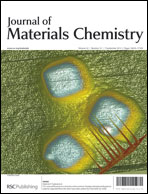Guided growth and alignment of millimetre-long titanate nanofibers in solution†
Abstract
Growth and alignment of nanofibers via single-step strategies are appealing goals in nanoscience studies and nanofiber-based device integration. We are inspired by the proficiency of the silkworm in manipulating one continuous thread in the space confined by the cocoon frame, and thus propose the guided growth and alignment of millimetre-long titanate nanofibers to macroscopic networks in solution by taking advantage of the unique surface properties of the periodical grooves patterned on the inner wall of a Teflon-lined autoclave. The textures of the networks can be controlled to be concentric rings or grids by tuning the geometry of the grooves. The growth mechanism of the networks is discussed on the basis of interfacial interactions. Furthermore, well-ordered networks consisting of millimetre-long heterostructured TiO2 nanofibers with an anatase backbone and monoclinic sheaths can be readily derived via the protonation and thermal


 Please wait while we load your content...
Please wait while we load your content...